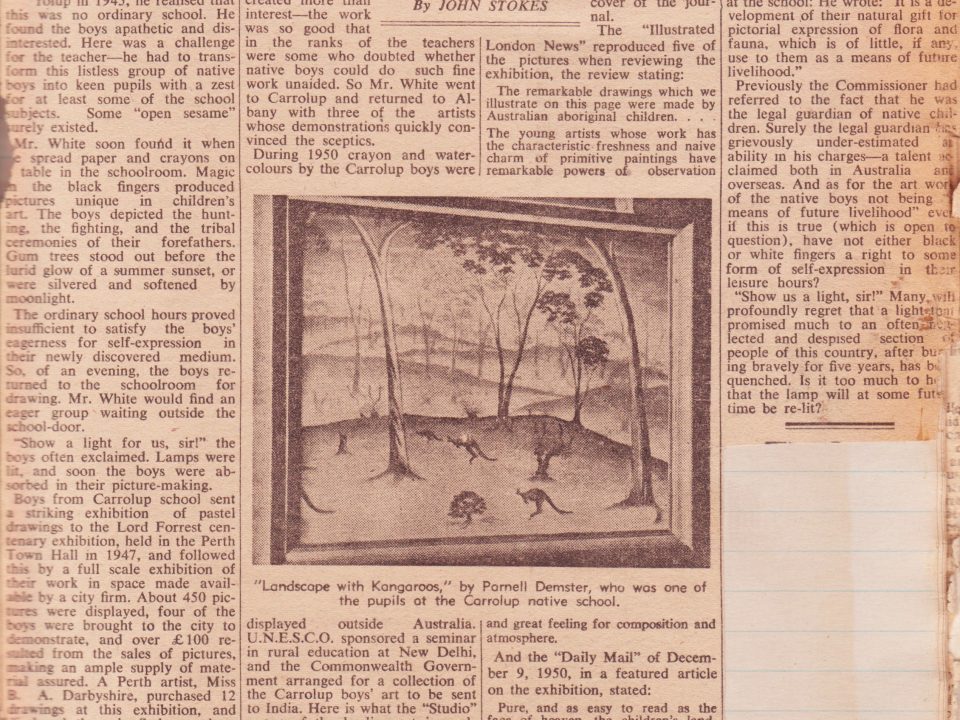Here is part of a chapter from my book Connection: Aboriginal Child Artists Captivate Europe which focuses on a newspaper article written by John Stokes after Carrolup Native Settlement school had been closed.
“In Perth, John Stokes, the teacher and headmaster who has done so much to promote the Carrolup children’s art and other achievements, writes a long article, Achievements of Carrolup Native Artists, for The West Australian on the 24th of February 1951. The article contains a picture of Parnell Dempster’s Landscapes with Kangaroos:
‘THE native settlement school at Carrolup has been closed, and the teacher who developed the remarkable artistic talent of the Carrolup native boys has been transferred. This is no less than astounding to the many people who are aware of the amazing results Mr. Noel White achieved during the five years that he was in charge of Carrolup school.’
Mr Stokes describes what has happened at Carrolup in terms of the development of the boys’ art since Mr White went to Carrolup in 1946, and how the art has gained a high reputation in various parts of the world.
‘When Mr. White went to Carrolup in 1945 [1946], he realised this was no ordinary school. He found the boys apathetic and disinterested. Here was a challenge for the teacher – he had to transform this listless group of native boys into keen pupils with a zest for at least some of the school subjects. Some “open-sesame” surely existed.
Mr. White soon found it when he spread paper and crayons on a table in the schoolroom. Magic in the black fingers produced pictures unique in children’s art. The boys depicted the hunting, the fighting, and the tribal ceremonies of their forefathers. Gumtrees stood out before the lurid glow of a summer sunset, or were silvered and softened by moonlight.
The ordinary school hours proved insufficient to satisfy the boys’ eagerness for self-expression in their newly discovered medium. So, of an evening, the boys returned to the schoolroom for drawing. Mr. White would find an eager group waiting outside the school-door.
“Show a light for us, sir!” the boys often exclaimed. Lamps were lit, and soon the boys were absorbed in their picture-making.’
John Stokes describes how the school sent the boys’ art to the Lord Forrest Centenary Exhibition in 1947, and had their own exhibition of 450 drawings in Boans store. He relates how Perth artist Miss B A Darbyshire purchased twelve drawings at the Boans exhibition, and displayed them in Sydney, where they caused a minor sensation in art circles.
He describes how the art was an outstanding feature of exhibits at the annual Katanning agricultural show. How the art was shown at a conference of 100 teachers in Albany. When some of the audience doubted that the boys could do such art, Mr. White went and fetched three boys from Carrolup, and they stunned their audience with a display of their drawing.
He relates how the Commonwealth Government had arranged for a collection of the pictures be sent to India for a UNESCO sponsored seminar. How The Illustrated London News had reproduced five of the pictures for their review of one of Mrs Rutter’s exhibitions in London.
Mr Stokes describes the reaction, in September 1950, of Studio, one of the leading art journals in the world:
‘The collection is remarkable for the vigour and vitality which shows in nearly every work… Illustrated with animated and significant detail, their subjects range from kangaroo-hunting to camp life and ceremonial dances. Some of the hunting and bush scenes in black crayon have the simple and striking appeal of Japanese and Chinese art. They feature friezes of speeding silhouettes and dramatically-conceived grass trees. Camp life scenes are full of amazing activity and characterisation.’
Mr Stokes later refers to Mr Middleton’s recent letter to The West Australian, where he gave his reasons to close the Carrolup school (cf. Chapter 39). Middleton said of the art:
‘It is the development of their natural gift for pictorial expression of flora and fauna, which is of little, if any, use to them as a means of future livelihood.’
Mr Stokes responds in his article:
‘Previously the Commissioner had referred to the fact that he was the legal guardian of native children. Surely the legal guardian has grievously under-estimated an ability in his charges – a talent acclaimed both in Australia and overseas. And as for the art work of the native boys not being “a means of future livelihood” even if this is true (which is open to question), have not either black or white fingers a right to some form of self-expression in their leisure hours?
“Show us a light, sir!” Many will profoundly regret that a light that promised much to an often neglected and despised section of people of this country, after burning bravely for five years, has been quenched. Is it too much to hope that the lamp will at some future time be re-lit?’” Connection: Aboriginal Child Artists Captivate Europe. David Clark, in association with John Stanton. Copyright © 2020 by David Clark
NB. Click on image at top to see it in its entirety.


